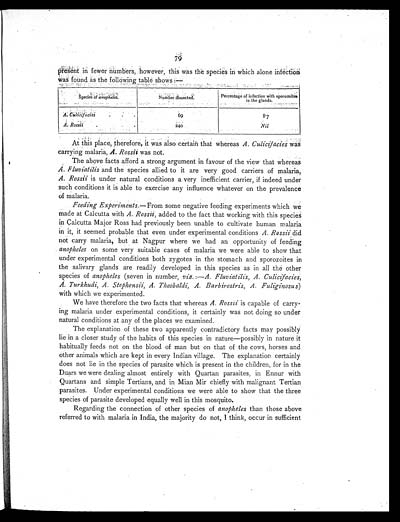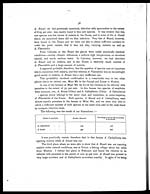Medicine - Institutions > Army health reports and medical documents > Scientific memoirs by officers of the Medical and Sanitary Departments of the Government of India > Number 2 - Malaria in India > Part II > Chapter III - Observations on the causes which influence the prevalence of malaria in different parts of India
(87) Page 79
Download files
Individual page:
Thumbnail gallery: Grid view | List view

79
present in fewer numbers, however, this was the species in which alone infection
was found as the following table shows.—
| species of anopheles | Number dissected | Percentage of infection with sporozoites in the glands. |
| A: culicifacies | 69 | 8.7 |
| A. Rossii | 240 | Nil |
At this place, therefore, it was also certain that whereas A. Culicifacies was
carrying malaria, A. Rossii was not.
The above facts afford a strong argument in favour of the view that whereas
A. Fluviatilis and the species allied to it are very good carriers of malaria,
A. Rossii is under natural conditions a very inefficient carrier, if indeed under
such conditions it is able to exercise any influence whatever on the prevalence
of malaria.
Feeding Experiments.—From some negative feeding experiments which we
made at Calcutta with A. Rossii, added to the fact that working with this species
in Calcutta Major Ross had previously been unable to cultivate human malaria
in it, it seemed probable that even under experimental conditions A. Rossii did
not carry malaria, but at Nagpur where we had an opportunity of feeding
anopheles on some very suitable cases of malaria we were able to show that
under experimental conditions both zygotes in the stomach and sporozoites in
the salivary glands are readily developed in this species as in all the other
species of anopheles (seven in number, viz.:—A. Fluviatilis, A. Culicifacies,
A. Turkhudi, A. Stephensii, A. Theobaldi, A. Barbirostris, A. Fuliginosus)
with which we experimented.
We have therefore the two facts that whereas A. Rossii is capable of carry-
ing malaria under experimental conditions, it certainly was not doing so under
natural conditions at any of the places we examined.
The explanation of these two apparently contradictory facts may possibly
lie in a closer study of the habits of this species in nature—possibly in nature it
habitually feeds not on the blood of man but on that of the cows, horses and
other animals which are kept in every Indian village. The explanation certainly
does not lie in the species of parasite which is present in the children, for in the
Duars we were dealing almost entirely with Quartan parasites, in Ennur with
Quartans and simple Tertians, and in Mian Mir chiefly with malignant Tertian
parasites. Under experimental conditions we were able to show that the three
species of parasite developed equally well in this mosquito.
Regarding the connection of other species of anopheles than those above
referred to with malaria in India, the majority do not, I think, occur in sufficient
Set display mode to: Large image | Zoom image | Transcription
Images and transcriptions on this page, including medium image downloads, may be used under the Creative Commons Attribution 4.0 International Licence unless otherwise stated. ![]()
| Permanent URL | https://digital.nls.uk/75022650 |
|---|
| Shelfmark | IP/QB.10 |
|---|---|
| Additional NLS resources: | |




